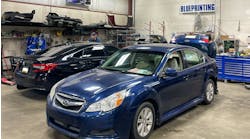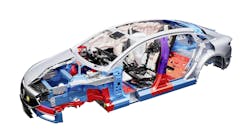Content brought to you by Auto Body Repair Network. To subscribe, click here.
If you’re a big fan of getting the first look into new car designs, you’ve probably noticed a distinctive change in the types of concept vehicles automakers have been rolling out at The SEMA Show and other auto shows over the past five years. Gone are the days when the focus was creating vehicles with advanced (and frequently, soon-to-be available) features highlighted by extreme paint jobs and other stylings. These days, you’re more likely to see a focus on style alone as automakers push the boundaries on vehicle design.
The reason for the change? “The future is now,” says Curtis Henderson, a senior analyst for Walcott Research, which provide investment information on the automotive market. “Consumers no longer have to wait five to ten years to see the latest auto technology made widely available, since a lot of these innovations come to market in just two years.” Henderson further explains that buyers are more interested in what’s under a vehicle’s skin—for example, high horsepower electric powerplants and self-driving systems—that will shortly be within their grasp.
For collision repairers, the express movement from research to market means that more than every they have their work cut out for them preparing to repair these vehicles. Henderson believes the toughest challenger for repairers resides even deeper under a vehicle’s hide, into the materials used to construct parts.
Ever since automakers began making extensive use of UHSS, they’ve been on course to add increasing loads of stronger and lighter advanced materials—typically plastics, aluminum, carbon fiber and even newer steels. In a repair world where the future is “now,” shops also are looking at newer advanced materials and the techniques needed to repair them. This means preparing now for tech that will appear tomorrow. As part of your prep, examine the following four trends that are determining what advancements in materials and their repair that you will soon be seeing.
Trend 1: All new materials, some from existing technology.
The two most significant forces driving the use of advanced materials continue to be increasing fuel efficiency (by reducing vehicle weight) and reducing vehicle emissions. To bolster both, manufacturers have turned to electric powertrains, but interestingly, this creates a problem. These new powertrains have tended to be heavier than traditional petroleum powered ones. As manufacturers have created more powerful electric engines to propel heavier vehicles such as trucks and SUVs (the most popular vehicles in their lineups), they’ve needed to incorporate more advanced materials to lighten the load. Henderson says this fact has driven the increased use of aluminum and carbon fiber. It also has compelled automakers to look at newer materials. Some of the most promising are combination of existing materials.
Enter combinations of ABS plastic and CFRP (carbon fiber reinforced plastic/polymer). CFRP, by itself, has proven capable of reducing weight by 10 percent compared to traditional fiberglass-reinforced composites. It’s become increasingly popular with auto manufacturers (BMW uses it to create roofs for its M models), so much so that the predicted compound annual growth rate (CAGR) for its use in automobiles by nearly 11 percent in 2023. Local Motors used this combination of technology to build the Olli, a lightweight self-driving electric bus created via 3D printing. Olli has served as a university shuttle for the Sacramento State University campus.
Meanwhile, the firm owned by McLaren F1 designer Gordon Murray has created a system dubbed iStream Superlight that combines carbon fiber and aluminum, dropping vehicle chassis weight by half. Plans remain in place to use the technology in sports cars and small city cars.
Even more revolutionary is the work being performed in universities to create all-new materials, including a resin created at Eindhoven University of Technology in the Netherland made from flax seed fibers and polylactic acid (PLA). The biodegradable resin reduces vehicle weight by five folds.
Full disclosure, Local Motors recently went out of business, while iStream Superlight and Eindhoven University’s resin remain in development stages. But that doesn’t mean these technologies or those like them will not come to market anytime soon. Henderson explains that due to the high cost of research, automakers are more likely to look outside their own businesses for breakthrough technologies. Even if these technologies are at first prohibitively expensive or have some drawbacks, if they still show promise there’s a reasonable chance they will be adopted.
“It wasn’t that long ago that carbon fiber or aluminum didn’t seem like good candidates for high use because of costs and other concerns,” Henderson says. “Yet here we are today seeing them being used throughout vehicle bodies in popular, affordable model lines.”
Trend 2: New bonds are on the way.
Advanced materials have carried with them new bonding techniques and products in the three areas where manufacturers and repairers create parts bonds: welding, fastening and adhesives. Each has significant disadvantages.
• Because of the heat it produces and the resistance of some materials, welding is not an option for certain advanced materials.
• Fasteners frequently don’t work with plastics/composites; they also can corrode and the holes they create can produce stress concentrations and therefore be points of structural failure.
• Adhesive bonds usually incorporate thermoset polymers, which can make repairs impossible.
Building on that last point, many of the techniques used at the factory can’t be performed in a shop, making alternative repairs using expensive equipment as the only option. Moreover, fasteners like bolts, rivets, clamps and clips add weight.
Promising research conducted at Michigan State University has created an adhesive that may be very quickly heated, forms a strong bond and cools in under a minute. Unlike fasteners, it doesn’t damage the material and expands the area of the bond, making it stronger and erasing stress concentrations. Unlike welding and other adhesives, it’s “reversible.” Such reversible bonding adhesives could be used in factories and, more significantly, in shops, simplifying and opening advanced material repairs to many repairers. Work continues with these adhesives, which have already shown much promise.
Trend 3: Recycled advanced materials will help drive the market.
The same parts you removed and threw out yesterday should be reappearing in new forms tomorrow. Not only are automakers reducing emissions on the vehicles they produce, but they’re also working hard to reduce their carbon footprint everywhere (Ford has plans to be carbon-neutral by 2050). This has translated into investing in the use of “green” materials – materials that have been recycled from previous use.
Audi recently worked with researchers on a project that processed the plastic waste from automotive manufacturing into pyrolysis oil that could replace petroleum as a material in the production of high-quality plastic components for Audi vehicles. Plastics have been recycled for years, but special consideration must be taken into account when using them in automobiles (in numerous components) where they must meet stringent requirements for safety, heat and stress resistance, and quality. Currently, plastic automotive components subject to particularly high levels of stress must be manufactured from virgin-quality materials. Further preventing the use of recycled plastics in automobiles is the fact that mixed plastic waste is often not available for mechanical recycling.
Since they exhibit the same high quality as virgin materials, pyrolysis oil plastics are suitable for manufacturing automobile components that are subjected to high stress. Audi says this could potentially increase the percentage of sustainably manufactured automotive components and eventually play a role in end-of-life vehicle recycling. All this is significant to an automaker that uses recycled materials throughout its A3 lineup and in its Q4 electric SUV that features 27 components containing recycled materials.
While recycled plastics in stressed components make their way to market, aluminum is quickly becoming the king of recycled advanced materials. In Europe, recycling rates for aluminum in end-of-life vehicles are especially high, with over 90 percent of the aluminum in cars being recovered. Most of the recovered aluminum contains a fraction of different alloys, creating what some engineers deem the ideal material for newly casted automotive components. Demand is expected to grow since utilizing recycled aluminum is the only way to meet demands for new EV vehicles. Expect the same phenomenon to take place in the U.S., where demand for aluminum will grow as the demand for EV vehicles does.
Indeed, the use of recycled parts is a key part of the future of automotive manufacturing where OEMs seek to build vehicles that are constructed entirely from older or totaled models. “Considering the cost of new materials and number of totaled cars, we might be moving towards this scenario faster than you’d believe,” says Henderson. “My worry is that with the cost or repairs skyrocketing in some cases and the number of totals, we might be looking at a future where cars are disposable items that are only repaired if the damage is relatively minor.”Trend 4: Consumers are going to demand vehicles with growing number of advanced materials.
In other words, advanced materials aren’t going anywhere and will, in fact, grow in usage as OEMs continue to update and revolutionize their offerings.
In Nov. 2022, Dodge announced that 2023 would be the last year its line of Chargers and Challengers would be fitted with its venerable and power V8 engines. Instead, the automaker would begin a transition to electric powerplants. “The pushback from muscle car fans should have been immense, since here was the last OEM holding the line on raw power saying goodbye to much of its history, but that didn’t happen,” says Ray Albright, owner of Top Gun Builders, a restoration shop in Sacramento, Calif.
Instead, Albright says, muscle enthusiasts turned the page and rather quietly accepted the change. “This was the last group of hardline folks who really pushed Detroit to hold onto its traditions, but now they’re focused on the future,” he says. “We have a lot of customers talking about electric and wanting to use cleaner, greener parts, and it’s not simply because we’re in California.”
Henderson says this viewpoint is shared by other consumers who now place fuel efficiency and available tech after cost when deciding to purchase a new vehicle. Moreover, corporate environmental responsibility is becoming increasingly important. “New vehicles are extremely expensive, so consumers expect more value. It’s no longer simply about four wheels and an engine,” he says.
For repairers, this means an equal investment in the future. Whether it’s training from I-CAR or OEM certifications, or continuous study of the auto industry, learning to repair today’s advanced materials and prepping for tomorrow’s innovations is the key to survival.





